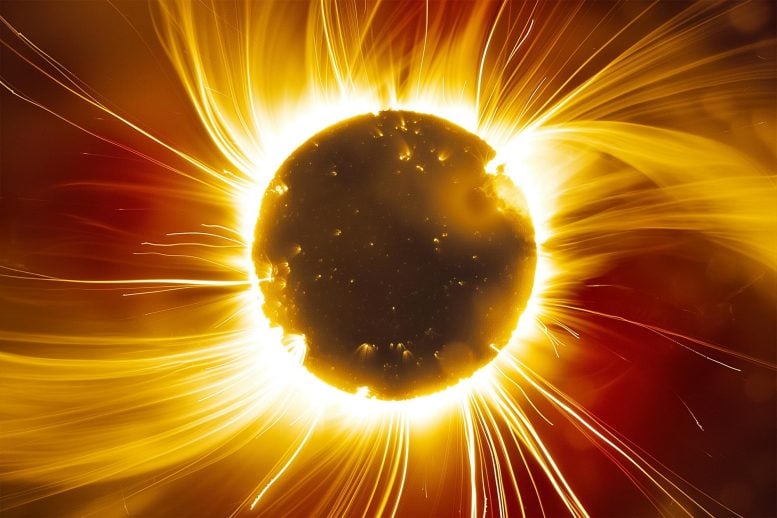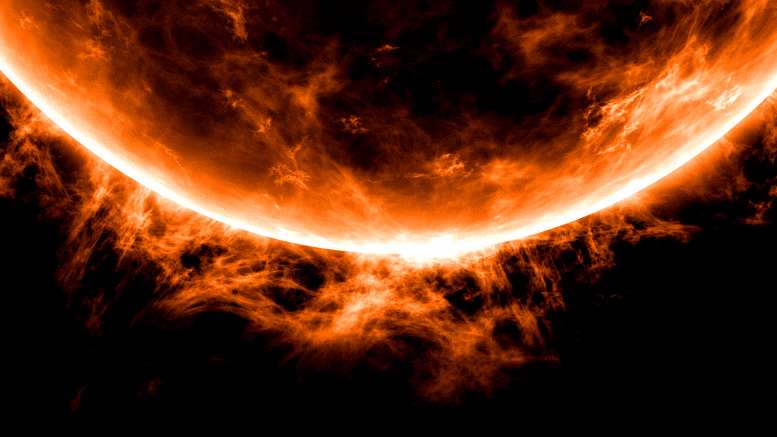
A new study delved into the mysterious heating of the solar corona, significantly hotter than the Sun’s surface, through the lens of kinetic Alfvén waves (KAWs).
Research at the University of Alabama in Huntsville investigated how these waves transport energy and contribute to solar coronal heating. The study explored the role of electromagnetic energy in space plasmas, focusing on how KAWs interact with particles, ultimately transforming this energy into heat. This work could provide critical insights into solar physics, particularly in understanding the temperature disparity between the Sun’s surface and its atmosphere.
Unraveling the Mysteries of Solar Corona Heating
A researcher from The University of Alabama in Huntsville (UAH) explored critical aspects of a phenomenon called kinetic Alfvén waves (KAWs) to provide fresh insights into an age-old heliophysics mystery in a new study published in The Astrophysical Journal. Syed Ayaz, a graduate research assistant at the UAH Center for Space Plasma and Aeronomic Research (CSPAR), examined the potentially pivotal role of KAWs in heating the solar corona, moving science one step closer to solving the puzzle of why the corona is many times hotter than the surface of the Sun itself.

The Role of Kinetic Alfvén Waves in Solar Physics
“For decades, Alfvén waves have been proven to be the best candidates for transporting energy from one place to another,” Ayaz says, noting the potential role of KAWs in driving coronal heat. “This paper utilizes a novel approach to model energetic particles in space plasmas, as observed by satellites like Viking and Freja, to answer how the electromagnetic energy of the waves, interacting with particles, transforms into heat during the damping process as the waves move through space. Our investigation explores the perturbed electromagnetic fields, Poynting flux vector, and the power delivery rate of KAWs in the solar atmosphere.”
The corona, or solar atmosphere, is an enigmatic region surrounding our home star that extends far beyond the visible disk of the Sun, stretching some eight million kilometers above the Sun’s surface. Yet, the corona is also characterized by extraordinarily high temperatures, a mystery that has captivated astrophysicists for nearly seventy years.

Researching Alfvén Waves at Kinetic Scales
“Syed is one of our outstanding students who is just starting out on his research career,” says Dr. Gary Zank, CSPAR director and the Aerojet Rocketdyne chair of the UAH Department of Space Science. “His abiding interest in Alfvén waves, started while a student in Pakistan when working with his mentor, Dr. Imran A. Kahn, has now resulted in his investigation of these waves at very small scales, the so-called kinetic scale in a plasma. His work offers important insights into the critical problem of how energy in a magnetic field is transformed to heat a plasma comprising charged particles like protons and electrons. One reason Syed’s work is important is because we still do not understand why the atmosphere of the Sun is more than one million degrees, compared to the surface of the Sun that is a comparatively cool 6,500 degrees.”
Kinetic Alfvén waves – abundant throughout the plasma universe – are oscillations of the ions and magnetic field as they move through the solar plasma. The waves are formed by motions in the photosphere, the Sun’s outer shell that radiates visible light.
“My primary interest in these waves was sparked by the launches of the Parker Solar Probe and Solar Orbiter missions, which raised the crucial question of how the solar corona is heated,” Ayaz says. “So far, no spacecraft mission has provided predictions regarding these phenomena close to the Sun, specifically, within the 0 – 10 solar radii range. Our primary focus is to investigate heating by KAWs within these ranges in the solar corona.”
Heated Exchanges: KAWs and Energy Transfer
“We focused on the heating and energy exchange facilitated by KAWs,” the researcher notes. “The reason for the great interest in these waves lies in their ability to transport energy. Observational data from numerous spacecraft and theoretical investigations have consistently demonstrated that KAWs dissipate and contribute to solar coronal heating during their propagation in space.”
Because of these unique properties, the waves provide a critical mechanism for transferring energy, important to understanding the energy exchange between electromagnetic fields and plasma particles. “KAWs operate on small kinetic scales and are capable of supporting parallel electric and magnetic field fluctuations, enabling an energy transfer between the wave field and plasma particles through a phenomenon called Landau interactions,” Ayaz says. “The present work utilized and explores the Landau damping mechanism, which occurs when particles moving parallel to a wave have velocities comparable to the wave’s phase velocity.”
Implications for Solar Atmosphere Research
Landau damping is an exponential decrease as a function of time of particular waves in plasma. “When particles interact with the wave, they receive/lose energy – a term called ‘resonant condition,’” Ayaz says. “This can result in the wave either delivering its energy to the particles or gaining energy from them, causing the particles to either damp or grow. Our research finds that KAWs rapidly dissipate, completely transferring their energy to plasma particles in the form of heating. This energy transfer accelerates the particles over longer spatial distances, significantly impacting the dynamics of the plasma.”
The analytical insights gleaned from this study will find practical application in understanding phenomena within the solar atmosphere, particularly shedding light on the significant role played by non-thermal particles in the heating processes.
Reference: “Solar Coronal Heating by Kinetic Alfvén Waves” by Syed Ayaz, Gang Li and Imran A. Khan, 26 July 2024, The Astrophysical Journal.
DOI: 10.3847/1538-4357/ad5bdc
1 Comment
Hannes Alfven himself made this clear: it is the ELECTRIC FORCE, not Alfven waves that heat the sun. What is the delusion of people thinking magnetism happens by itself and gravity is a fundamental force? While typing on electronics, no less.